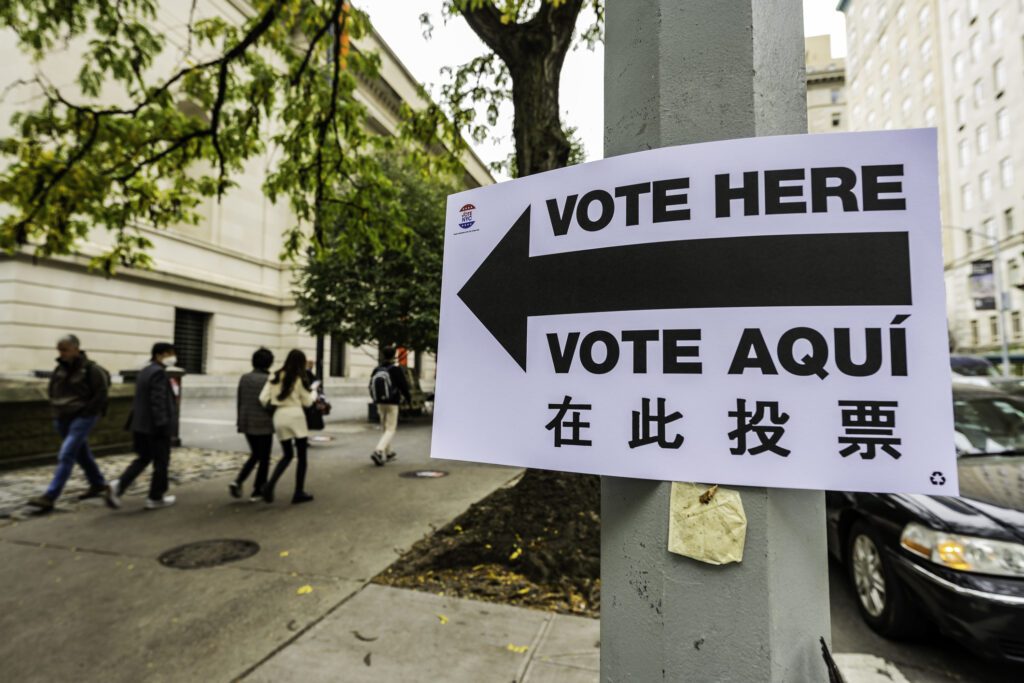Facing a More Diverse Electorate In ’24, Democratic Consultants Are Working to Test Drive Media Strategies

Image Credit: Christine McCann
Democratic firms may have a secret weapon going into 2024: non-partisan work for government elections agencies.
As concerns around election integrity and voter participation have ramped up since 2020, so too has the work available for local election agencies.
To wit, Democratic consulting firms have won contracts with elections officials in New York and LA — the largest, most diverse U.S. cities — giving them a chance to test drive cross-channel, multi-lingual media programs, which could give them an edge over Republican consultants going into 2024.
That’s because the presidential cycle is anticipated to have a new-look electorate where young Americans and voters of color could play an outsized role.
Thomas Blake, a SVP of paid media at Fenton Communications in New York, said June 6 during a webinar hosted by DSPolitical that his firm has picked up business in recent years from local government elections agencies.
“Over the last few years, we’ve been really active in supporting election integrity efforts for a variety of different clients in a variety of different capacities,” he said. “This has included building omni-channel, voter education advertising campaigns.”
In addition to working in New York for the city’s Campaign Finance Board, an independent agency tasked with sharing information about voting, Fenton has worked in LA where it’s supported the LA County Registrar’s Office on its voter education campaigns since 2020.
“So we were able to take a lot of learnings about how to reach voters in a multi-culturally, nuanced way,” he said. “And apply them to this campaign, which is a real benefit.”
Tuesday’s webinar that featured Blake as a speaker highlighted a recently published DSPolitical case study that detailed a 2022 campaign in New York City on behalf of the Campaign Finance Board, which had the “unprecedented” effect of increasing participation by young voters under 30 and newly naturalized immigrant voters by 1.6 percentage points — a figure that BlueLabs Analytics helped quantify.
The advertising campaign split the two universes and focused on zip-code based targeting for newly naturalized voters and hit them with ads on programmatic, CTV, display and video, but also Facebook, Snap, Google (search), YouTube and Twitch. Meanwhile, they targeted lists for young voters.
“This young voter audience were the folks who moved the most,” said Jacob Garber, a VP at DSPolitical. According to the case study, turnout among voters under 30 reached by the ads increased by 2.8 percentage points.
Meanwhile, Blake said they also learned that social pressure, which is an effective mobilization tactic commonly used down-ballot, isn’t the only way to help drive up turnout.
“It does contribute to overall negative feelings around voting and the election system,” said Blake. “The tactic relies on guilt and fear, rather than inspiration and empowerment … so that’s why we were so excited about these tests: to see if we could prove whether or not [this alternative approach] would also be effective at mobilizing voters. And to see if that’s something that could be replicated by other municipalities or potentially even campaigns.”
The increased engagement they saw from youth voters, he added, “gave us confidence in the approach we’ve been taking.”
Mitchell Cohen, content strategy manager at New York’s Campaign Finance Board, said his agency also got some takeaways from the paid media program. Most notable, he said, was the importance of taking risks.
In fact, the board devoted part of its budget to testing during this program for the first time. It also made its largest ever investment in Snap, and advertised on streaming platform Twitch for the first time.
The board is now advertising to raise awareness of New York City’s primary election, which happens June 27. “We were able to really build in a lot of the findings from this campaign — even some of the platform decisions that we were making,” Cohen said.
